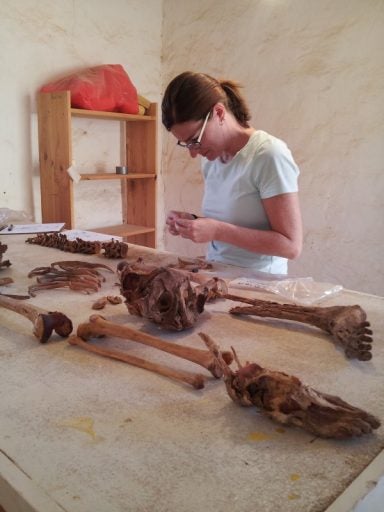Sandra Wheeler graduated with multiple degrees in anthropology from UCF and returned in 2010 as an instructor specializing in bioarchaeology. Her main area of research focuses on the bioarchaeological analysis of infants and children, which recently led her to uncovering the earliest recorded evidence of child abuse. Her findings were reported by national media. She enjoys hanging out with her friends, hiking, going to the movies, trying new restaurants and crafting beer.
What inspired you to pursue your area of research?
I knew from early on I wanted to be an archaeologist but it wasn’t until graduate school that I figured out what kind of archaeologist I wanted to be. My focus became understanding the actions, behaviors, birth, life and death of people in the past through analyses of their bodies themselves. This approach combined with the archaeological context made bioarchaeology, a subdiscipline of anthropology, a perfect fit. My doctoral work focused on combining these two realms of data to understand human activities in the past.
How long have you worked on the site where you and your team discovered evidence of child abuse?
I have been a member of the Dakhleh Oasis Project since 2005. The Dakhleh Oasis is one of the major oases in the Western Desert of Egypt and has been continuously occupied by humans since Neolithic times. The Dakhleh Oasis Project is an international, multidisciplinary project. Its mandate is to understand human adaptation to desert environments over time. The cemetery where our team is currently conducting research is called Kellis 2 and is dated to the Romano-Christian period (ca. 50-450 AD). This cemetery represents some of the earliest mortuary evidence for Christianity in Egypt; as such our team is investigating these early mortuary practices as well as analyzing the human remains from the cemetery.
My research focus is the analysis of infant and child skeletons, so I was particularly interested in this case as it represented an unusual pattern of skeletal trauma, not only for an individual this young, but also for this population.
Were you specifically looking for signs of child abuse when you were conducting your research?
As a bioarchaeologist, I study human remains and their mortuary contexts in order to make interpretations about people’s lives in the past. This includes analyses of health and disease, growth and development, diet, migration and trauma, among other things. This case stood out as we have excavated about 770 individuals from the cemetery to date, over 400 of which are children.
This individual was the only one displaying this unusual pattern of trauma, so we knew we needed to investigate it further. Also, this child was very young to have the number and degree of skeletal fractures present, so it was very suspicious and uncharacteristic for this population.
How did you feel when you realized you played a role in such an important discovery?
I was thankful and excited to be a part of a team of amazing researchers who brought this case study to publication. We knew this paper would have a great impact in our field, and I am pleased with how it has been received within my discipline as well as the public arena. This case study highlights the contributions of anthropology to understanding human behavior in the past and our contributions to modern discourse on children and childhood from a cross-cultural perspective.
What do you most love about your job?
My current job is as an instructor so there is a heavy emphasis on teaching. Teaching is something I really enjoy. I like engaging students in diverse topics and challenging them to think about the world in different ways. It has been rewarding to see my students graduate and continue on in anthropology and other fields knowing that in some small measure I helped contribute to their success.
Of all your accomplishments to date, which one has meant the most to you?
Like many recent graduates my happiest accomplishment has been finding a job that I enjoy where I can interact with students and continue to conduct research in my field of study.
Do you do any community/volunteer work?
I do some volunteer work for the Center for Great Apes in Wachula. This is a non-profit great ape sanctuary that provides lifetime care for chimpanzees and orangutans that have been rescued from the entertainment industry, private zoos and pets.
For more information about Wheeler’s research, “Shattered lives and broken childhoods: Evidence of physical child abuse in ancient Egypt,” click here.
